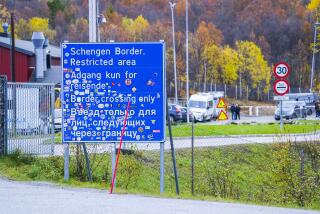Norway-Soviet Border: Relaxed Lunches and Saunas Replace Cold War
- Share via
KIRKENES, Norway — On this low-key border between the Soviet Union and Norway, the only territorial violations are committed by reindeer, and differences of ideology are temporarily forgotten in sauna baths and snowmobile races.
There are no ugly Cold War scenes on this border, one of two frontiers between a NATO country and the Soviet Union--the other is Turkey’s--and dramatic dashes across the Pasvik River by Soviet citizens to a new life in the West are virtually unknown.
In the last four decades, there has not been a shot fired in anger along the 130-mile border that snakes through Norway’s Finnmark region on the Arctic edge of Europe, Norwegian security officials say.
East-West hostility here has been replaced by a cordiality based on a careful, friction-free observance of each other’s border rights and duties.
‘Not a Dramatic Border’
Relations stop well short of friendship. But Norwegian Border Commissioner Inge Torhaug said: “I am pleased to say this is not a dramatic border. We do not want it to be one and nor do the Soviets.”
Soviet and Norwegian army patrols occasionally spot each other through the pines and silver birch trees. Salutes are rare, but incidents nonexistent.
For Norwegians, the formal, if sometimes stuffy, cordiality at the border is part of a wider national policy of keeping tension low in an area that is potentially explosive.
Due east is the Soviet Kola Peninsula and the ice-free port of Murmansk, harboring what a Norwegian admiral described as the “world’s highest concentration of offensive maritime power,” including 60% of Moscow’s strategic submarine fleet.
Strategic Position
The position of Norway, with a long jigsaw-puzzle coastline of fiords that are ideal for submarine navigation, is regarded by the North Atlantic Treaty Organization as the key to the defense of the alliance’s northern flank against a threat from the Soviets.
Despite nuances in Norway’s position in NATO stemming in part from the neutralist traditions of Scandinavia, opinion polls show that Norwegians heavily favor continued alliance membership.
But with an unevenly spread population of only 4 million people, Norway thinks that a classic deterrent posture has to be linked with a profile of reassurance toward its superpower neighbor.
Thus, it does not allow NATO exercises in Finnmark.
Border Meetings
Torhaug, a 60-year-old brigadier formerly in Norwegian counterintelligence, meets once or twice a month with his Soviet counterpart, a colonel of the KGB’s border guard force, to discuss border protocol.
The daylong meetings, provided for in a 1949 border agreement, begin and end with ritualistic border ceremonies, though something more spontaneous follows once official record books are closed.
Torhaug and Soviet Lt. Col. Vladimir Kirilov meet at the border for an opening ceremony in which the host side makes a formal speech of invitation to the other to step across the frontier.
They then hold formal discussions, alternately at the Skorskog Commission building on the Norwegian side or in the Boris and Gleb post on the Soviet side.
Mundane Topics
There is no ideologically charged talk here. Discussion covers distinctly mundane topics: how to realign and whether to repaint some of the 415 wooden border markers or arrange for retrieving river buoys moved by the current into the other’s territory.
The nearest they come to discussing defections is arranging for Norwegian herders to recover reindeer that every winter wander across the frozen Pasvik.
Once business is out of the way, Torhaug says, genuine conviviality often takes over, a relaxed lunch, sometimes followed by sauna bathing, shooting competitions or snowmobile races.
“We try to steer clear of political and defense matters,” Torhaug said. “We discuss literature, music, that kind of thing.”
Alcohol Cutback
Until Soviet leader Mikhail S. Gorbachev launched his anti-alcohol drive, a Norwegian border commissioner had to have a strong liver to match the Russians’ capacity for endless toasting with gulps of straight vodka.
“We would return to the border in the evening as best we could,” Torhaug said. “The lunches are more sober affairs now, thanks to Gorbachev.”
Torhaug told a group of journalists who met him at the border conference building at Skorskog near here, “It is definitely not a stress job.”
Torhaug has to log and report all border activities. But under the 1949 agreement, he is also obliged to prevent Western visitors from making provocative or insulting gestures across the border.
No Photographs
He also has to stop Norwegians from taking photographs of the border, partly out of deference to Soviet sensitivities.
For his Soviet counterpart, the worst thing that can happen is for a Soviet soldier to defect or an ordinary citizen to escape into Norway.
The Soviet border commissioner’s task is made easier since the population on the Kola is mostly military personnel--and 850 to 1,000 KGB border guards.
The 1979 defection of a Soviet soldier from Pechenga “stopped promotion for a lot of (Soviet) officers,” Torhaug said. One Soviet KGB border officer told him, “Nobody bothers us as long as nobody crosses.”
He recalls how one Soviet border official became obsessed with finding the body of one of his men who had drowned in the Pasvik in a fishing accident.
“He was so relieved when he found the body,” Torhaug said. “It was the only way he could prove that the man had not defected.”
More to Read
Sign up for Essential California
The most important California stories and recommendations in your inbox every morning.
You may occasionally receive promotional content from the Los Angeles Times.













